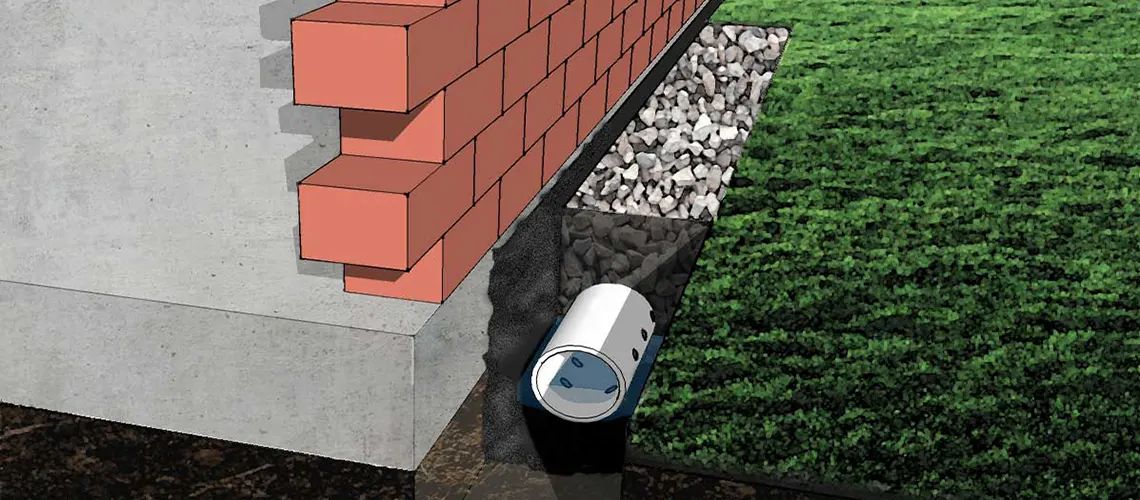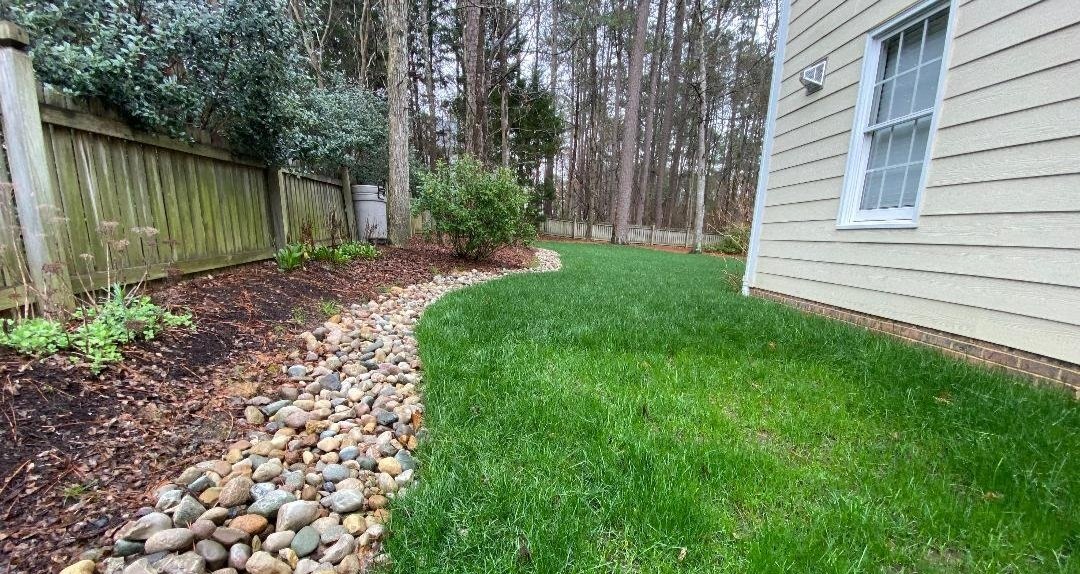How a Portland French Drain Protects Against Lower Level Flooding
How a Portland French Drain Protects Against Lower Level Flooding
Blog Article
Exactly How a French Drainpipe Can Aid Prevent Water Damage in Your Basement
If you're taking care of a wet basement, a French drain may be the option you require. Portland French Drain. This system successfully redirects water away from your foundation, helping to avoid expensive damages. Recognizing how it works and acknowledging the signs that you need one can make a significant difference in your home's security and comfort. Before you decide, it's essential to explore the benefits and installation procedure to see if it's the appropriate fit for your scenario.
What Is a French Drainpipe?
A French drainpipe is a basic yet efficient option for handling excess water around your residential property. It's created to redirect water away from susceptible areas, like your cellar or structure. Normally, it is composed of a trench full of gravel and a perforated pipeline that accumulates and channels water. When rainwater or groundwater develops, the drainpipe effectively guides it away, preventing possible damage.You could discover French drains pipes set up along residential or commercial property lines, driveways, or perhaps near your home's foundation. They can be found in different sizes and arrangements, making them versatile to different landscapes and water drainage needs. Installing a French drainpipe can help you stay clear of expensive repairs and shield your home's structural honesty. If you've been handling water merging or soaked areas in your lawn, a French drainpipe might be the service you need. It's an aggressive step to assure your residential property remains dry and secure from water-related issues.
Exactly how Does a French Drainpipe Work?
A French drain kicks right into activity to redirect it successfully when water collects around your property. This system consists of a trench full of gravel and a perforated pipe near the bottom. The pipe gathers excess water from the soil and networks it far from your foundation.As rainwater or groundwater seeps into the gravel, it moves via the perforations and into the pipe. Gravity does the job, drawing the water far from your basement and directing it to an assigned water drainage area, like a storm drain or dry well.You can set up a French drainpipe either inside or outside your home. If you select an exterior configuration, it'll protect against water from merging near your foundation. An interior drain will capture water that leaks with your basement wall surfaces. This reliable layout maintains your room dry, allowing you to appreciate your home without the fear of water damages.
Advantages of Setting Up a French Drainpipe
Setting up a French drain can considerably enhance your home's durability against water damage. You'll appreciate reliable water diversion, which aids minimize mold and mildew development and shield your property. And also, a properly maintained water drainage system can even boost your home's value.
Effective Water Diversion

Lowered Mold And Mildew Growth
Considering that wetness produces a perfect environment for mold and mildew to prosper, minimizing water build-up around your home is important for preserving a healthy living room. Mounting a French drain efficiently networks excess water far from your foundation, maintaining your basement dry. This aggressive action considerably reduces humidity degrees, making it harder for mold spores to resolve and grow.With less dampness, you'll discover it simpler to breathe and appreciate a tidy, safe setting. Plus, you'll reduce the danger of health concerns connected with mold and mildew exposure, such as allergies and respiratory troubles. By investing in a French drainpipe, you're taking a vital step toward a mold-free cellar, ensuring that your home continues to be a comfortable area for you and your family.
Raised Home Worth
A French drain can considerably increase your building's value, making it a smart investment for home owners. When potential purchasers see a properly maintained basement without water damages, they're more probable to be satisfied. This feature not only boosts your home's appeal however additionally signals that you've taken proactive steps to secure it. By lowering the risk of water-related problems, your residential property comes to be more attractive in an open market, commonly bring about greater offers. Furthermore, the lasting financial savings on repairs and maintenance can equate right into increased equity. Installing a French drainpipe shows you appreciate your home's stability, comforting customers that they're making a sound purchase. Eventually, it's a beneficial addition that settles in more means than one.
Signs You Need a French Drain
If you observe consistent water build-up in your yard or basement, it's a clear indicator that you may require a French drainpipe. In addition, a mildewy odor can indicate trapped dampness, which can cause bigger troubles. Attending to these signs early can aid protect against severe water damage to your home.
Persistent Water Buildup
When you observe persistent water buildup around your home, it's a clear indication that a French drainpipe may be essential. Water pooling near your structure can lead to substantial damage with time, including structural problems and mold and mildew growth. You need to pay interest to locations where water seems to accumulate after heavy rainfalls or snowmelt. It's time to take activity if your backyard stays soaked for days. In addition, seek signs of disintegration or sloppy patches, as these can show poor drain. Mounting a French drain aids redirect water away from your home, securing your structure and decreasing the threat of water damages. Don't wait on bigger concerns to emerge-- attending to water buildup now can conserve you costly repair work later on.
Stuffy Odor Existence
Persistent water buildup typically leads to this link more than simply noticeable pooling; it can produce an atmosphere ripe for stuffy smells. If you discover a wet, stagnant scent in your basement, it's an indication that dampness is sticking around, typically because of inadequate water drainage. This smell commonly indicates mold or mold development, which can posture health dangers and damage your belongings. You might locate that the scent gets worse during humid weather or after heavy rains. It's time to assess a French drain if you're fighting consistent musty smells. This system redirects water far from your structure, minimizing dampness degrees and combating those undesirable smells. Do not neglect this caution sign; addressing it quickly can save you from more comprehensive water damage down the line.
The Installation Process of a French Drain
Mounting a French drainpipe can be a straightforward process that greatly boosts your home's water damages prevention. Examine the area where you desire to mount the drain, ensuring it slopes away from your structure. Next, note the trench's course, which must have to do with 6-8 inches broad and 18-24 inches deep.Excavate the trench, eliminating dirt as needed. Portland French Drain. As soon as you have actually got your trench, set landscape textile to avoid dirt from clogging the drain. After that, add a layer of gravel at the base. Location a perforated pipeline on top of the crushed rock, making sure the openings deal with downward for reliable drainage.Cover the pipe with even more gravel, leaving regarding 3 inches of space at the top. Fold up the landscape fabric over the crushed rock to safeguard it. Fill in the trench with dirt, compacting it as you go. You have actually now established up a reputable system to reroute water away from your cellar!
Maintenance Tips for Your French Drainpipe
A French drain is made to efficiently handle water circulation, regular maintenance is vital to validate its ongoing performance. Begin by evaluating the drain and its surroundings for debris or obstructions. Clear any kind of fallen leaves, dirt, or sediment that may collect, specifically after hefty rains.Next, check the electrical outlet for proper drain. It must route water far from your structure-- if it does not, you may need to adjust its setting. Furthermore, validate that the crushed rock bordering the drainpipe is intact and hasn't settled in time; this assists preserve appropriate water flow.Consider arranging a yearly expert examination to capture any kind of concerns early. If you see any kind of indicators of water damages or pooling, resolve them instantly to avoid larger problems in the future. With a little interest, your French drain can successfully secure your basement for many navigate here years to come.
Cost Factors To Consider and Long-Term Financial Savings
When taking into consideration a French drain, it's important to evaluate both the preliminary financial investment and the long-lasting cost savings it can provide. While the ahead of time price may seem substantial, think of it as an investment in your home's future. Mounting a French drain generally varies from $1,500 to $5,500, relying on your cellar's size and the complexity of the installation.However, this price can conserve you thousands in prospective water damage, mold removal, and structure fixings. By protecting against water buildup, you're likewise safeguarding your home's worth and staying clear of pricey insurance coverage cases. Furthermore, a completely dry basement can decrease your energy costs, as moisture can bring about boosted heating & cooling costs. Eventually, the assurance that includes recognizing your home is secured from water damages is invaluable. Think about these factors thoroughly to make an educated decision that profits you in the future.

Regularly Asked Inquiries
Can a French Drainpipe Be Mounted in Any Type Of Sort Of Dirt?
Yes, a French drainpipe can be installed in numerous dirt types, consisting of loam, sand, and clay. Nonetheless, appropriate installation and drain planning are necessary to ensure it functions successfully in your particular dirt problems.
How Long Does a French Drainpipe Last Prior To Needing Replacement?
A French drainpipe commonly lasts around 30 to 40 years with correct installment and maintenance. Nonetheless, elements like dirt kind look at this now and water flow can influence its lifespan, so watch on its efficiency.
Can French Drains Pipes Aid With Backyard Drain Issues?
Yes, French drains pipes can successfully deal with lawn drainage concerns. They direct excess water away from issue locations, preventing merging and ensuring your landscape stays healthy. Mounting one can significantly improve your yard's total drain efficiency.
Will a French Drain Affect My Landscaping or Yard?
A French drainpipe can impact your landscape design or garden, specifically if it's set up improperly. You'll intend to ensure it's put strategically to reduce interruption, protecting your plants and overall visual while boosting drainage.
Exist Alternatives to French Drainpipes for Basement Water Concerns?
Yes, there are options to French drains for basement water issues. You might consider sump pumps, waterproof coverings, or grading your yard to redirect water away. Each alternative has its advantages, so assess what fits your needs best. When rainwater or groundwater builds up, the drainpipe successfully overviews it away, stopping prospective damage.You might notice French drains pipes mounted along property lines, driveways, or also near your home's foundation. Gravity does the work, drawing the water away from your cellar and guiding it to a designated drainage location, like a storm drain or completely dry well.You can set up a French drain either inside or outside your home. By effectively carrying water away from your home, a French drain can considerably lower the threat of water damages. Mounting a French drain assists redirect water away from your home, protecting your structure and decreasing the risk of water damages. Setting up a French drain can be an uncomplicated process that greatly improves your home's water damage avoidance.
Report this page